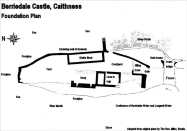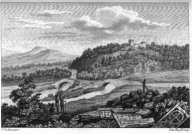 | Introduction | The Castles | Images | Links | History Of Caithness | Glossary | A to Z of Caithness |
• Reconstruction Paintings • Ground Plans • Area Plans • Photo Galleries • Non-Caithness Castles Paintings |
| Berriedale Castle, Caithness Map Ref: ND 122214 Landranger Sheet 17 Berriedale Castle From The Air
28 July 03 Introduction
In descending from the Ord of Caithness, Berriedale Castle was probably the first medieval fortification to be encountered, sitting on a tongue of rock projecting across the mouth of the Berriedale River. Berriedale Castle was developed from a 14th Century stronghold of Sir Reginald Cheyne who possessed so many of these structures in Caithness at that time that his influence on the county was very considerable. There may have been an even earlier fortification on the site.
It is quite likely that there may have been a postern gate and a haven on the Western side of the promontory and the painting, taken from a Western perspective, shows a trebuchet on the Northern wall - a counterpoised war engine for hurling rocks. The flags flown are the colours of the Oliphants. The castle was established by the Cheynes but passed through marriage to the Sutherlands and then the Oliphants who held it until it was disponed to the Earl of Caithness in 1606. The Lairds of Berriedale were also the Lairds of Old Wick Castle and they possessed about a quarter of the lands of Caithness at the height of their power. For further information about these families click on the link to Historic Families of the North by D. B. Miller. References:
Also See: |










